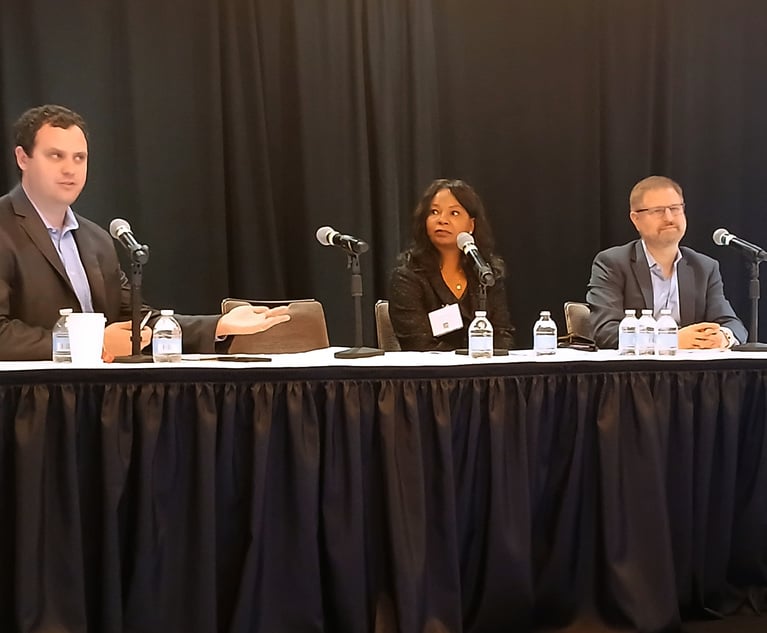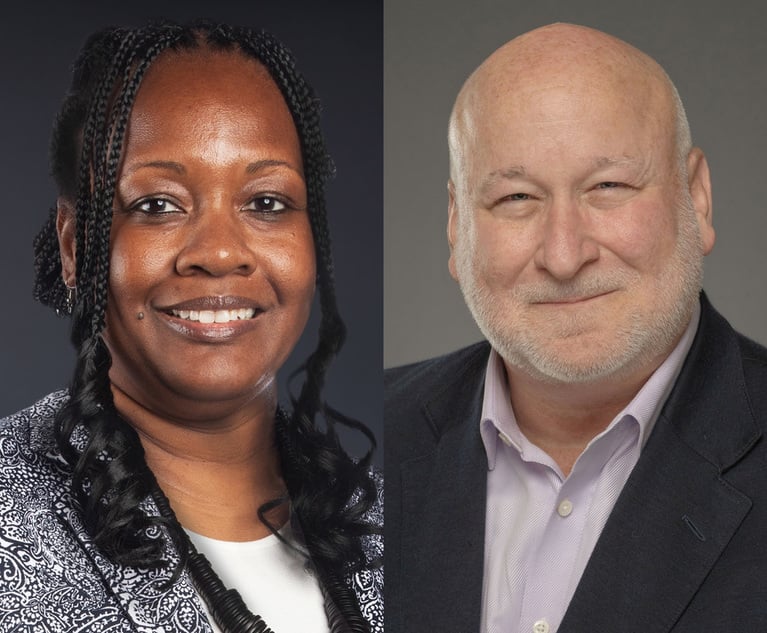A tale of two soft cost recoveries: Developing a defensible, verifiable cost recovery policy
The majority of firms still use the traditional cost recovery model, even though by doing so, those firms may be losing money on many recoverable items.
April 05, 2012 at 06:38 AM
9 minute read
The original version of this story was published on Law.com
It was the winter of despair
In Part 1 of this series, I described the relatively recent erosion of soft cost recovery occurring in law firms as it is seen from the firm's point of view. The majority of firms still use the traditional cost recovery model, even though by doing so, those firms may be losing money on many recoverable items. This decline in the recovery of costs is predicated largely on the fact that clients are much more sensitive to what they view as extraneous charges, ultimately breeding systemic mistrust in the validity of the costs of these charges.
The client's mistrust of these charges extends back to the firms and falls primarily upon the shoulders of the attorneys who are handling these clients. This, in turn, causes the attorneys to be ever more hesitant to pass through these charges in the first place—and so goes the cycle of erosion.
It was the spring of hope
This is not necessarily a healthy situation if it is given that the law firms that represent your organization incur legitimate costs, and the goal is both fairness in billing practices and good communication between your organization and an outside law firm.
From the point of view of the client when faced with these issues, however, how do you position the law firms that service your organization to recover these legitimate costs in a fair and equitable fashion? From the client side, your organization has a number of options:
- Decide what costs (if any) your organization is willing to reimburse the law firms that service you.
- If your company generates a significant amount of legal business, you may want to take the position that your firm will negotiate these charges and that you will not pay for any soft costs.
This position can significantly impact the firm's operations, however. The firms you are conducting business with will be reluctant to keep this type of work on-site (soft costs) because they are not getting reimbursed for it. When organizations take this stance, they should expect a significant amount of hard cost pass-throughs (outside vendor invoices). This may result in a slowing down of work product turnaround.
- If your organization takes the position to reimburse your outside law firm's soft costs, you should develop a clear, concise and well-thought-out policy. Many of our clients struggle with policies that are inconsistent; this often results in delays that frustrate both parties.
Some examples of where this frustrating logic may lead are:
- Clients will reimburse for faxes but not for scans. The justification for this reasoning may be that faxes are an acceptable way of delivering documents, but scans are not. In the end, however, this encourages firms to fax documents at a dollar per page, whereas scanning the same documents would have cost 10 percent of that amount.
- Sometimes clients take the position to only reimburse hard costs. Law firms, then, will send documents overnight (via FedEx or UPS) rather than simply scanning the document and sending it via email, a less expensive, more expedient and eco-friendly solution.
- Clients will not pay for prints but will pay for copies. This logic does not represent how law firms and people in general are working today.
We had everything before us
It is completely logical that an organization would want to have clear guidelines in place for these costs. However, the guidelines should be reasonable, determined with the goal of keeping costs and work product turnaround time to a minimum, recognize the standard working practices of today's law firms and ultimately not hamper the workflow between your organization and the law firm.
From the law firm side, the healthy solution is to formulate a clear, defensible policy that will minimize both internal and external write-offs. To that end, develop a plan that improves communication with your attorneys, improves their ability to communicate with their clients and encompasses the following:
- A clear definition of how your costs are developed and an explanation of indirect or overhead costs.
- A benchmark of your costs against other firms of similar size and geography. If your costs are out of line, then they may not be competitive or your overhead allocation may be excessive.
- Education for your attorneys and staff on how the costs are developed and the ramifications of what happens when they are written off. Give your attorneys the ammunition to defend themselves when a client is taking a hard line stance.
In the final installment of this series we will discuss if alternative methods are the way to go.
It was the winter of despair
In Part 1 of this series, I described the relatively recent erosion of soft cost recovery occurring in law firms as it is seen from the firm's point of view. The majority of firms still use the traditional cost recovery model, even though by doing so, those firms may be losing money on many recoverable items. This decline in the recovery of costs is predicated largely on the fact that clients are much more sensitive to what they view as extraneous charges, ultimately breeding systemic mistrust in the validity of the costs of these charges.
The client's mistrust of these charges extends back to the firms and falls primarily upon the shoulders of the attorneys who are handling these clients. This, in turn, causes the attorneys to be ever more hesitant to pass through these charges in the first place—and so goes the cycle of erosion.
It was the spring of hope
This is not necessarily a healthy situation if it is given that the law firms that represent your organization incur legitimate costs, and the goal is both fairness in billing practices and good communication between your organization and an outside law firm.
From the point of view of the client when faced with these issues, however, how do you position the law firms that service your organization to recover these legitimate costs in a fair and equitable fashion? From the client side, your organization has a number of options:
- Decide what costs (if any) your organization is willing to reimburse the law firms that service you.
- If your company generates a significant amount of legal business, you may want to take the position that your firm will negotiate these charges and that you will not pay for any soft costs.
This position can significantly impact the firm's operations, however. The firms you are conducting business with will be reluctant to keep this type of work on-site (soft costs) because they are not getting reimbursed for it. When organizations take this stance, they should expect a significant amount of hard cost pass-throughs (outside vendor invoices). This may result in a slowing down of work product turnaround.
- If your organization takes the position to reimburse your outside law firm's soft costs, you should develop a clear, concise and well-thought-out policy. Many of our clients struggle with policies that are inconsistent; this often results in delays that frustrate both parties.
Some examples of where this frustrating logic may lead are:
- Clients will reimburse for faxes but not for scans. The justification for this reasoning may be that faxes are an acceptable way of delivering documents, but scans are not. In the end, however, this encourages firms to fax documents at a dollar per page, whereas scanning the same documents would have cost 10 percent of that amount.
- Sometimes clients take the position to only reimburse hard costs. Law firms, then, will send documents overnight (via FedEx or UPS) rather than simply scanning the document and sending it via email, a less expensive, more expedient and eco-friendly solution.
- Clients will not pay for prints but will pay for copies. This logic does not represent how law firms and people in general are working today.
We had everything before us
It is completely logical that an organization would want to have clear guidelines in place for these costs. However, the guidelines should be reasonable, determined with the goal of keeping costs and work product turnaround time to a minimum, recognize the standard working practices of today's law firms and ultimately not hamper the workflow between your organization and the law firm.
From the law firm side, the healthy solution is to formulate a clear, defensible policy that will minimize both internal and external write-offs. To that end, develop a plan that improves communication with your attorneys, improves their ability to communicate with their clients and encompasses the following:
- A clear definition of how your costs are developed and an explanation of indirect or overhead costs.
- A benchmark of your costs against other firms of similar size and geography. If your costs are out of line, then they may not be competitive or your overhead allocation may be excessive.
- Education for your attorneys and staff on how the costs are developed and the ramifications of what happens when they are written off. Give your attorneys the ammunition to defend themselves when a client is taking a hard line stance.
In the final installment of this series we will discuss if alternative methods are the way to go.
This content has been archived. It is available through our partners, LexisNexis® and Bloomberg Law.
To view this content, please continue to their sites.
Not a Lexis Subscriber?
Subscribe Now
Not a Bloomberg Law Subscriber?
Subscribe Now
NOT FOR REPRINT
© 2025 ALM Global, LLC, All Rights Reserved. Request academic re-use from www.copyright.com. All other uses, submit a request to [email protected]. For more information visit Asset & Logo Licensing.
You Might Like
View All
Legal Tech's Predictions for Legal Ops & In-House in 2025

Lawyers Drowning in Cases Are Embracing AI Fastest—and Say It's Yielding Better Outcomes for Clients

GC Conference Takeaways: Picking AI Vendors 'a Bit of a Crap Shoot,' Beware of Internal Investigation 'Scope Creep'
8 minute readTrending Stories
- 1Former Phila. Solicitor Sozi Tulante Rejoins Dechert
- 2'I've Seen Terrible Things': Lawyer Predicts Spike in Hazing Suits
- 3SEC Ordered to Explain ‘How and When the Federal Securities Laws Apply to Digital Assets’
- 4NY Trial Court Halts State Dragnet on Licensed Hemp Operators
- 5Report: US Attorney E. Martin Estrada to Resign From California's Central District
Who Got The Work
Michael G. Bongiorno, Andrew Scott Dulberg and Elizabeth E. Driscoll from Wilmer Cutler Pickering Hale and Dorr have stepped in to represent Symbotic Inc., an A.I.-enabled technology platform that focuses on increasing supply chain efficiency, and other defendants in a pending shareholder derivative lawsuit. The case, filed Oct. 2 in Massachusetts District Court by the Brown Law Firm on behalf of Stephen Austen, accuses certain officers and directors of misleading investors in regard to Symbotic's potential for margin growth by failing to disclose that the company was not equipped to timely deploy its systems or manage expenses through project delays. The case, assigned to U.S. District Judge Nathaniel M. Gorton, is 1:24-cv-12522, Austen v. Cohen et al.
Who Got The Work
Edmund Polubinski and Marie Killmond of Davis Polk & Wardwell have entered appearances for data platform software development company MongoDB and other defendants in a pending shareholder derivative lawsuit. The action, filed Oct. 7 in New York Southern District Court by the Brown Law Firm, accuses the company's directors and/or officers of falsely expressing confidence in the company’s restructuring of its sales incentive plan and downplaying the severity of decreases in its upfront commitments. The case is 1:24-cv-07594, Roy v. Ittycheria et al.
Who Got The Work
Amy O. Bruchs and Kurt F. Ellison of Michael Best & Friedrich have entered appearances for Epic Systems Corp. in a pending employment discrimination lawsuit. The suit was filed Sept. 7 in Wisconsin Western District Court by Levine Eisberner LLC and Siri & Glimstad on behalf of a project manager who claims that he was wrongfully terminated after applying for a religious exemption to the defendant's COVID-19 vaccine mandate. The case, assigned to U.S. Magistrate Judge Anita Marie Boor, is 3:24-cv-00630, Secker, Nathan v. Epic Systems Corporation.
Who Got The Work
David X. Sullivan, Thomas J. Finn and Gregory A. Hall from McCarter & English have entered appearances for Sunrun Installation Services in a pending civil rights lawsuit. The complaint was filed Sept. 4 in Connecticut District Court by attorney Robert M. Berke on behalf of former employee George Edward Steins, who was arrested and charged with employing an unregistered home improvement salesperson. The complaint alleges that had Sunrun informed the Connecticut Department of Consumer Protection that the plaintiff's employment had ended in 2017 and that he no longer held Sunrun's home improvement contractor license, he would not have been hit with charges, which were dismissed in May 2024. The case, assigned to U.S. District Judge Jeffrey A. Meyer, is 3:24-cv-01423, Steins v. Sunrun, Inc. et al.
Who Got The Work
Greenberg Traurig shareholder Joshua L. Raskin has entered an appearance for boohoo.com UK Ltd. in a pending patent infringement lawsuit. The suit, filed Sept. 3 in Texas Eastern District Court by Rozier Hardt McDonough on behalf of Alto Dynamics, asserts five patents related to an online shopping platform. The case, assigned to U.S. District Judge Rodney Gilstrap, is 2:24-cv-00719, Alto Dynamics, LLC v. boohoo.com UK Limited.
Featured Firms
Law Offices of Gary Martin Hays & Associates, P.C.
(470) 294-1674
Law Offices of Mark E. Salomone
(857) 444-6468
Smith & Hassler
(713) 739-1250







